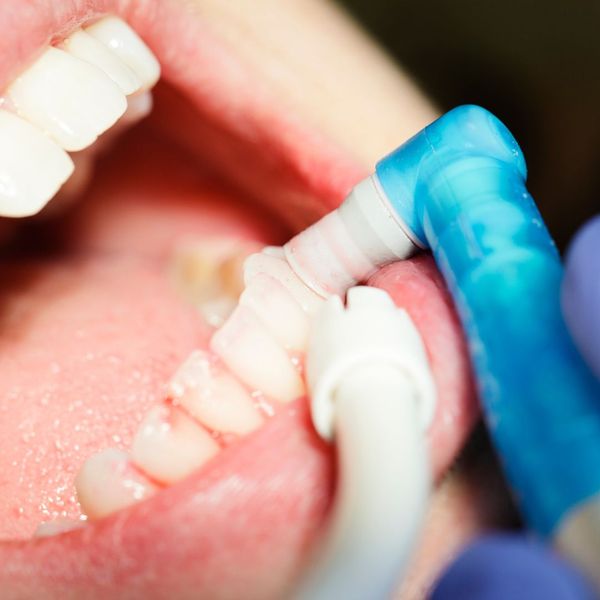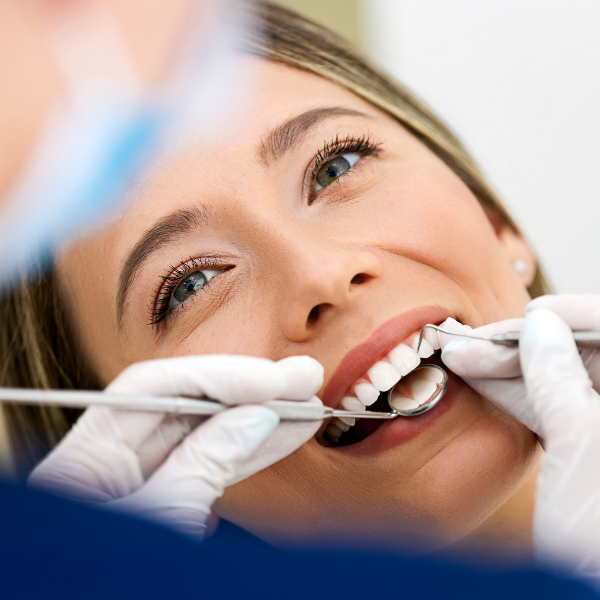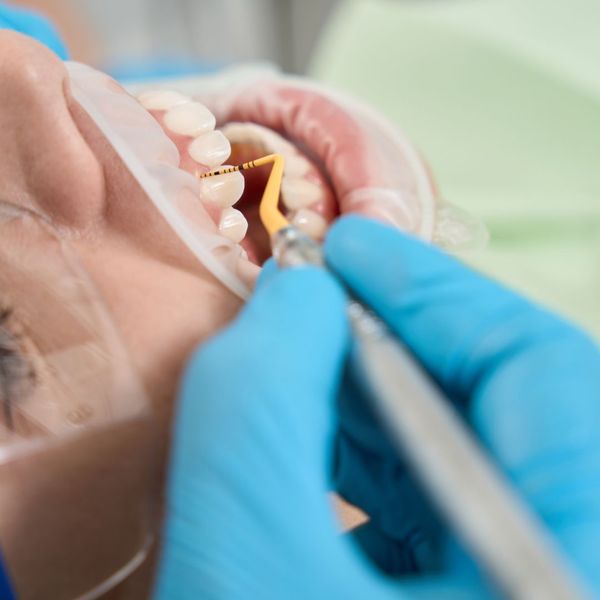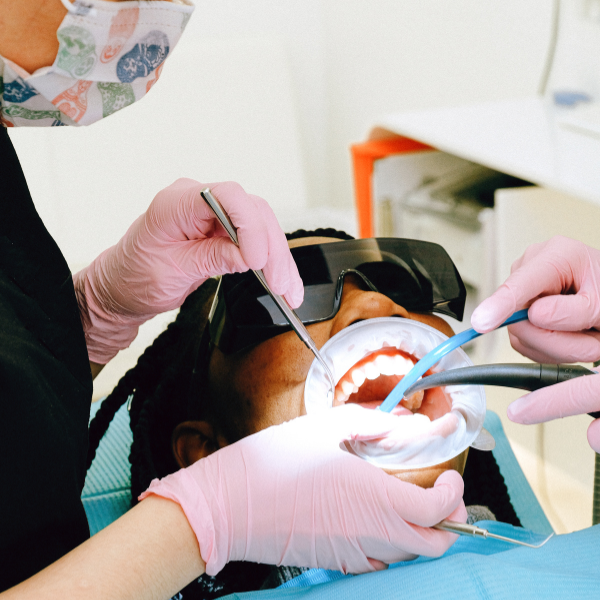Preventive Dentistry
Preventive Dentistry
Our main focus at McDowell Dentistry of Goodyear is on prevention, ensuring early detection and intervention to maintain healthy teeth and gums. From thorough exams and X-rays to professional cleanings and advanced treatments such as full mouth debridement and scaling and root planing, our dedicated team is committed to providing comprehensive care.

While our expertise spans from dental implants to teeth whitening and various cosmetic dentistry enhancements, we also prioritize preventative care as a cornerstone of our practice. Our team of experienced dentists is dedicated to providing personalized care to optimize your dental well-being. It’s our mission to safeguard your oral health, prevent dental problems, and ensure that your smile remains vibrant and problem-free for years to come.
Experience proactive dental care that prioritizes your well-being and helps you achieve a healthy, radiant smile. Schedule a general dentistry appointment with us now!

Exam and X-Rays
Exam and X-ray examinations provide valuable information that helps Dr. Ayoub evaluate your oral health. With the help of X-rays, Dr. Ayoub can look at what is happening beneath the surface of your teeth and gums. Radiographs allow our same-day dentists to see hidden abnormalities, like tooth decay, infections, and signs of gum disease.
How often X-rays should be taken depends on the patient's oral health, age, risk of disease, and any signs and symptoms of oral disease a patient may be experiencing. For example, children may require X-rays more often than adults because their teeth are more likely affected by tooth decay.

Cleanings/Adult Prophylaxis (Cleanings)
Cleanings/Adult prophylaxis is commonly called an annual teeth cleaning and should be performed every six months. It is a preventive dental service that includes scaling and polishing of the teeth to remove plaque, calculus, and stains above the gumline. It also reduces gingivitis, which is an inflammation of the gums that may cause bleeding.

Full Mouth Debridement
Full Mouth Debridement is a very thorough deep cleaning that is typically needed if you have an excessive buildup of calculus or have some form of gingivitis or periodontitis. That is because the significant accumulations may obstruct a thorough oral examination.
The intensive cleaning process is typically recommended for individuals who have not had regular dental cleanings in several months or years, leading to severe tartar accumulation. This makes it challenging for the dentist to conduct a detailed evaluation of the oral health condition. This general dentistry option from our offices in Arizona gives patients a clean slate for subsequent dental treatments and establishes a foundation for ongoing oral care maintenance.

Scaling and Root Planing
Scaling and root planing is the most common and conservative form of treatment for periodontal (gum) disease. Scaling is the removal of calculus (commonly called tartar) and plaque that attach to the tooth surfaces. The process especially targets the area below the gum line, along the root. Plaque is a sticky substance, full of bacteria, that forms on teeth. When plaque hardens over time, it is called calculus. Plaque is more likely to stick to rough surfaces. For this reason, the root surface is made smooth in a process called root planing. Root planing removes any remaining calculus and smoothes irregular areas of the root surface.

Periodontal Maintenance
Periodontal maintenance is an ongoing program designed to prevent disease in the gum tissues and bone supporting your teeth. Regular dental cleanings are conducted every six months; however, periodontal maintenance requires more frequent check-ups and cleanings, every three months.
Individuals with a history of periodontal disease or those prone to gum inflammation may require more frequent professional cleanings to manage their condition effectively. This increased frequency of annual teeth cleanings also allows for closer monitoring of oral health status, early detection of potential concerns, and prompt intervention to maintain healthy gums and prevent further damage. If you’re worried about the health of your teeth, contact McDowell Dentistry of Goodyear now for preventive dentistry!

Fluoride Treatments
Fluoride treatments you receive in Dr. Ayoub’s office have more fluoride than over-the-counter fluoride mouthwash or toothpaste. They are used for both children and adults. Dental-office treatments also are different chemically and stay on the teeth longer.
There are two common types of professionally applied fluorides. Acidulated phosphate fluoride (APF) is acidic; neutral sodium fluoride is not. Neutral sodium fluoride usually is used for people who have dry mouth (xerostomia) or who have tooth-colored fillings, crowns or bridges. An acidic fluoride may irritate a mouth that is dry. It also can create small pits in composite fillings.
Fluoride is applied as a gel, foam, or varnish during a dental appointment. The teeth are dried so the fluoride doesn't become diluted. Fluoride can be applied by using a tray that looks like a mouth guard for one to four minutes. Fluoride also can be painted directly on the teeth. It comes in a variety of flavors, but it should never be swallowed.
Demineralization begins with the type of bacteria that causes plaque on your teeth. These bacteria feed on sugar in your mouth and produce acids. The acids dissolve the crystals in your teeth. Remineralization builds the enamel back up. In this process, minerals such as fluoride, calcium, and phosphate are deposited inside the enamel. Too much loss of minerals without enough repair of the enamel leads to tooth decay.
Fluoride strengthens teeth by helping to speed remineralization. It also helps to stop bacteria from making acids. Teeth can absorb fluoride in two ways. One way is through the small doses that children swallow in food, supplements, and fluoridated water. This fluoride enters the bloodstream and becomes part of the permanent teeth as they develop. The teeth become stronger, so it is harder for acids to destroy the enamel.
Fluoride also can enter teeth directly in the mouth. This occurs in several ways:
When you get a fluoride treatment at the dental office
When you brush with fluoride toothpaste or use a fluoride rinse
When fluoridated water washes over your teeth as you drink
Fluoride treatments commonly are given to children as their teeth are developing. If your child has a history of cavities or is at high risk of decay, he or she should use additional fluoride. This promotes remineralization of the teeth. Many children get fluoride treatments every six months. The treatments provide extra protection against cavities, even if children already drink fluoridated water.
Frequently Asked Questions
Preventative dentistry is essential for maintaining healthy teeth and gums, helping to prevent common dental issues such as cavities, gum disease, and enamel wear. By practicing good oral hygiene at home and visiting your dentist regularly, you can avoid more serious dental problems in the future. Below are some frequently asked questions about preventative dentistry, aimed at helping you understand the importance of proactive dental care and how to keep your smile healthy for life.

What is the goal of preventative dentistry?
The goal is to preserve your natural teeth, prevent cavities, and avoid gum disease through proactive care and regular dental checkups.

What is the difference between preventative and restorative dentistry?
Preventative dentistry aims to stop dental issues before they occur, while restorative dentistry repairs damage that has already happened, such as filling cavities or crowns for damaged teeth.

How often should I visit the dentist for preventative care?
It's generally recommended to see a dentist every six months for a cleaning and checkup, but your dentist may recommend more frequent visits based on your needs.

Can children benefit from preventative dentistry?
Yes, children can benefit greatly from early preventative care, including sealants and fluoride treatments, which help protect their developing teeth.

Can preventative dentistry stop gum disease?
Yes, regular cleanings and proper oral hygiene can prevent gingivitis, the early stage of gum disease, and help maintain healthy gums.

What is the role of fluoride in preventative dentistry?
Fluoride strengthens tooth enamel and helps protect against cavities by making teeth more resistant to acid attacks from plaque.

Are dental sealants necessary?
Sealants are recommended for children and some adults to protect the grooves in molars from decay, as these areas are prone to cavities.

How does stress impact dental health?
Stress can lead to habits like teeth grinding (bruxism), which can wear down teeth, and it may weaken your immune system, making you more prone to gum disease. Regular dental checkups can help manage these issues.

Can I practice preventative dentistry at home?
Yes, brushing twice a day, flossing daily, and maintaining a healthy diet are essential parts of preventative care you can do at home.

Does insurance cover preventative dentistry?
Most dental insurance plans cover basic preventative care, including cleanings, exams, and x-rays. But if you do not have dental insurance, feel free to reach out to our team to discuss alternative payment methods.
Make Your Preventive Dentistry Appointment Now
At McDowell Dentistry of Goodyear, we pride ourselves on offering comprehensive and cutting-edge services that cater to all your dental needs. Trust us to deliver proactive and preventive measures that safeguard your oral health and preserve the beauty of your smile for years to come. Explore the preventive dentistry and annual teeth cleanings at McDowell Dentistry of Goodyear and take the first step towards maintaining a healthy and radiant smile today.
